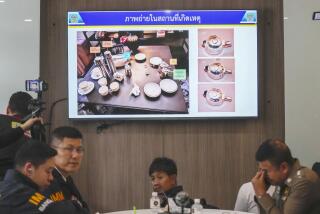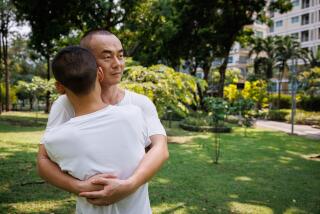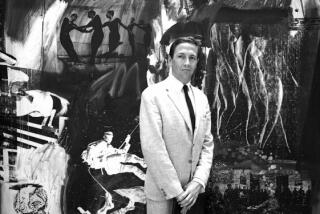Thailand’s White Temple a sanctuary for Buddha — and Hello Kitty
What do Kung Fu Panda, Neo from “The Matrix” and Spider-Man all have in common? If you guessed some sort of vague celebrity, you’d be half-right.
These characters share a wall inside the White Temple, a Gaudí-esque Buddhist sanctuary a few miles outside Chiang Rai in northern Thailand, where I visited in December. I had been hankering to see it since I stumbled upon the offbeat structure while surfing the Internet during the run-up to my tour of Asia.
As controversial as it is mesmerizing, the shimmering edifice is the brainchild of visual artist and designer Chalermchai Kositpipat, who began working on his self-funded masterpiece in 1997.
Even with 60-plus volunteers, Kositpipat estimates that Wat Rong Khun will not be complete until the end of the century.
The 60-year-old muralist first brought his unique aesthetic to Wat Buddhapadipa, Britain’s first Thai Buddhist temple, constructed in Wimbledon in 1982. Kositpipat headed a team of Thai artists who adorned its walls with images of Moammar Kadafi, Ronald Reagan and Margaret Thatcher.
“I got complaints from everybody — from the [Thai] government, from monks and from other artists, saying that what I was doing was not Thai art,” Kositpipat was quoted as saying after finishing the project.
The White Temple is even more intriguing than its British cousin and a vast departure from the 33,000 traditional temples found throughout Thailand. The interior of the main chapel is painted with characters, including Harry Potter, Hello Kitty and Freddy Krueger, participating in a war between good and evil. The devil is literally in the oddly disarming details.
This goes for outside as well. Consider the red-painted fingernail on one of the hundreds of sculpted hands reaching up from a pit of demonic souls. To gain access to the main temple, I had to cross this macabre scene using a bridge called the Cycle of Rebirth. I’ve visited many temples in my travels, but this was the first time I’d entered a sanctuary not knowing whether to laugh or cry out in fear.
But even before setting foot on the 6.4-acre property, I had to cross a road punctuated by red and white traffic cones topped with ghoulish faces. Then, in the temple gardens, I encountered moss-covered masks of wretched faces hanging from trees along with blood-colored skeletons — Marlboros in hand — warning of the dangers of smoking.
The Golden Toilet is one of the complex’s most curious structures, an ornate restroom building covered in gold leaf. The idea, said local guide Phubordin Thitipongkul, is to call attention to our materialistic tendencies. “Gold is for the lay people. White is for the enlightened people,” Thitipongkul said.
As one of the country’s most celebrated artists, Kositpipat may get away with what appears to be frivolousness. But squint and you might think you’re passing into the great beyond when this seemingly snow-covered structure first meets your gaze. Twinkling in the sun, Wat Rong Khun, for all its wackiness, is still a place of worship.
In fact, Kositpipat believes the project will give him “immortal life.”
“Every human has to see this,” he told Time magazine in 2009. “This is my way, and a good way, to give back to the world.”
As for the temple’s untraditional white color, Kositpipat didn’t just choose it for artistic effect. Rather, he wanted Wat Rong Khun to be what Thitipongkul called “an emblem of enlightenment.” Add to that the countless mirrored glass mosaics embedded in the white plaster that denote Buddha’s wisdom “shining throughout the universe.”
I found inner contemplation challenging as I began to enter the ubosot, or chapel. Blaring nonstop was a loudspeaker urging visitors to “keep moving.”
After I removed my shoes and observed several “No Photo” signs, I entered a room that didn’t seem unusual. Straight ahead was a giant painting of the Buddha on a wall covered in shades of gold. In front of it sat a couple of Buddha statues, one white and the other gold.
But it was the back wall that captured my attention with its parade of cartoon characters, action heroes and a depiction of New York’s twin towers. One of the buildings was smoldering.
If you’ve spent time touring the country’s Buddhist temples, you won’t be surprised by images depicting historic and religious events such as the battle between the Buddha and the demon Mara, but here you’ll see George W. Bush and Osama bin Laden painted inside the demon’s eyes.
“I want everyone to know that our world is being destroyed by those who craved to build weapons that kill, thereby ruining the environment because nothing is ever enough,” Kositpipat wrote in the temple’s English-language guidebook.
If all this seemed out of place, I considered that the ancient scenes I usually encountered were not always ancient. In fact, the only difference here is that Kositpipat is continuing the tradition of illustrating temple walls with contemporary Buddhist cosmology.
As Thitipongkul noted, the artist wanted to create a record of the time period when a particular painting was done.
“In 500 years, if people discover this as an ancient temple, people will ask when it was made,” Thitipongkul said. “But then they’ll see the ‘Matrix’ image and realize that it’s from the 21st century.”
On May 5 of last year, a 6.3-magnitude earthquake in nearby Mae Lao damaged some of the compositions, cracking pillars and breaking a spire. Although Kositpipat at first thought the damage was irreparable, it was soon determined that it could be repaired within two years.
That is merely a blip in a multi-decade project like this one. Besides, the many architectural details obscured the damage.
That goes for Kositpipat himself, who Thitipongkul said walks the grounds. But no worries if you don’t catch him. You can do as I and many others have done: pose for a photo next to a life-size cardboard likeness of the artist outside the gift shop.
::
Visiting Chiang Rai, Thailand
If you go
THE BEST WAY TO CHIANG RAI, THAILAND
From LAX, Thai Airways offers connecting service (change of planes) to Chiang Rai. Restricted round-trip fares from $1,696, including taxes and fees.
TELEPHONES
To call Chiang Rai from the United States, dial 011 (the international dialing code), 66 (the country code for Thailand) and the local number.
The White Temple, Pa O Don Chai Road, A. Muang, Chiang Rai. Open daily 6:30 a.m. to 6:30 p.m. Admission is free, but donations are accepted. The art gallery with displays of some of Chalermchai Kositpipat’s paintings is open 8 a.m. to 5:30 p.m. By car, it’s an eight-mile, 20-minute drive southwest of the city on Highway 1. A taxi will cost about $9. The cheapest option is by bus from the center of town for 62 cents one way.
WHERE TO STAY
The Legend, 124/15 Moo 21 Kohloy Road, Amphur Muang, Chiang Rai; 53-910-400, https://www.thelegend-chiangrai.com. Comfortable boutique hotel in a peaceful setting on the banks of the Mae Kok River. Good launching point for day trips to the nearby countryside. Expect to pay about $200 per night (online rate from $75).
Le Patta Hotel, 610 Phahonyothin Road Wieng, Chiang Rai; 53-600-680, https://www.lepattachiangrai.com. In the center of town just a short walk from the Night Market and other attractions. About $100 per night.
WHERE TO EAT
You’ll find a couple of restaurants across the street from the temple serving typical Thai fare. Otherwise, save your appetite for …
Leelawadee Restaurant, 58/2 Moo 19 Khwaewai Road, Ropwiang, Mueang Chiang Rai District, Chiang Rai; 53-600-000, https://www.leelawadeechiangrai.com/en. Just outside town on the Mae Kok River, with panoramic views. Spicy minced pork salad, fresh bitter melon fried in oyster sauce and steamed prawns in a clay pot.
Salung Kham, 884 Phaholyothin Road (Highway 1, about 1,200 feet north of the King Mengrai Monument), 53-717-192, https://www.salungkham.com (the site is mostly in Thai, but if you click around you’ll find some good images of the food). Serves traditional northern Thai dishes such as northern-style sausage and seasonal veggies in green chile paste.
TO LEARN MORE
Tourism Authority of Thailand, https://www.tourismthailand.org/Chiang-Rai
More to Read
Sign up for The Wild
We’ll help you find the best places to hike, bike and run, as well as the perfect silent spots for meditation and yoga.
You may occasionally receive promotional content from the Los Angeles Times.






